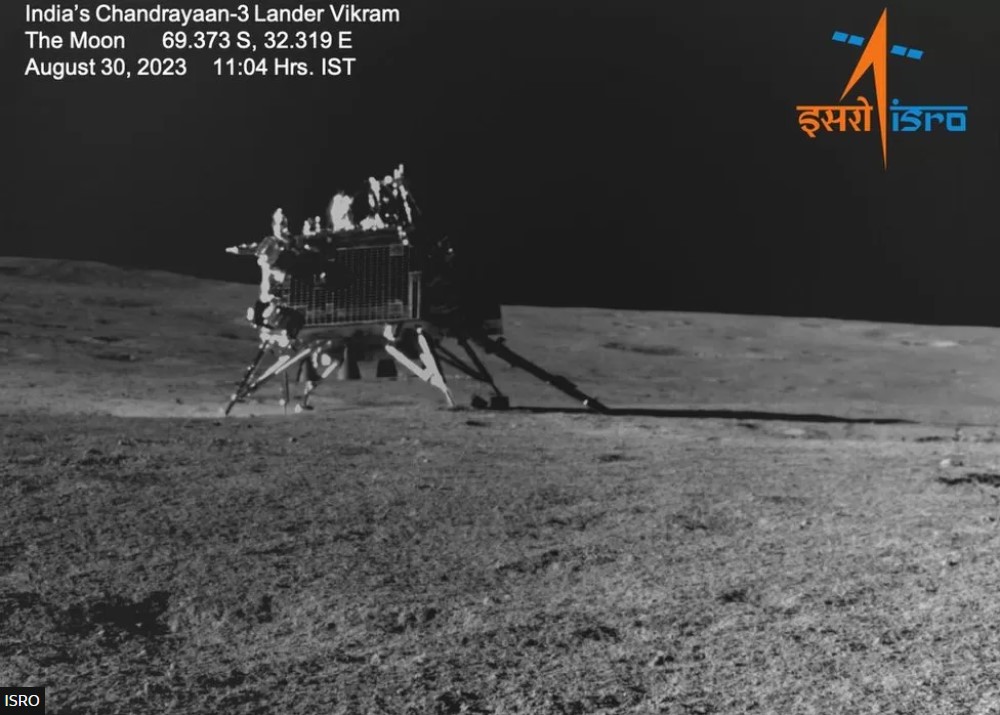India's Chandrayaan-3 Lander and Rover Fail to Wake Up After Lunar Night
Universe Today, September 29, 2023
India's Chandrayaan-3 lander and rover have encountered a critical issue, failing to reawaken after the lunar night concluded on September 27, 2023. The Indian Space Research Organisation (ISRO) has been diligently attempting to re-establish communication with the spacecraft since then, but their efforts have thus far been in vain.

Lunar Night: A Chilling Challenge
The lunar night is a grueling period spanning two weeks during which the Moon's surface is plunged into an abyss of darkness. Temperatures plummet to as low as -173 degrees Celsius (-280 degrees Fahrenheit). Spacecraft operating on the Moon must be equipped to endure these harsh environmental conditions. ISRO had expressed optimism that the Chandrayaan-3 lander and rover would spring to life once the Sun made its triumphant return.
Potential Damage During the Cold Embrace
Regrettably, it appears that the lunar night might have taken a toll on the spacecraft. ISRO, however, has not disclosed specific details regarding the cause of this setback. One plausible theory suggests that the extreme cold could have inflicted damage upon the delicate electronic systems of the lander and rover.
The Setback for India's Space Ambitions
The Chandrayaan-3 lander and rover's failure to revive marks a significant setback for India's burgeoning space program. Nevertheless, ISRO is demonstrating resilience by announcing its preparations for the Chandrayaan-4 mission, slated for launch in 2025.
Analysis: A Glimpse into the Challenges of Space Exploration
The Chandrayaan-3's setback serves as a stark reminder of the formidable challenges inherent to space exploration. Even seemingly minor technical issues can lead to substantial setbacks. However, the fact that India is already making strides towards the Chandrayaan-4 mission underscores the nation's unwavering commitment to its space endeavors.
Reflecting on Past Missions
Prior to Chandrayaan-3, India had embarked on two lunar missions: Chandrayaan-1 and Chandrayaan-2. Both were resounding successes in reaching lunar orbit. However, Chandrayaan-2 encountered an unfortunate mishap during its attempted lunar landing in 2019.
The Mission's Scientific Objectives
Chandrayaan-3 bore the responsibility of deploying a rover known as Pragyaan, charged with exploring the Moon's surface for traces of water and other valuable minerals. Additionally, the rover was equipped with an array of sophisticated scientific instruments designed to investigate the Moon's unique environment and geology.
The Inherent Risks of Space Exploration
The Chandrayaan-3 mission's unanticipated halt serves as a poignant reminder of the inherent risks in space exploration. Even the most advanced space agencies across the globe have grappled with failures along the way. The essence lies in the ability to derive valuable lessons from these experiences and to persevere in the quest for greater understanding and discovery.
The Chandrayaan-3 mission's setback may have dimmed the lights momentarily, but it has not extinguished India's aspirations for lunar exploration. As the nation looks forward to the Chandrayaan-4 mission, it is abundantly clear that India's dedication to the frontiers of space remains steadfast and resolute.
Frequently Asked Questions
-
What caused the Chandrayaan-3 mission's failure? The exact cause remains undisclosed, but it's theorized that extreme cold during the lunar night may have damaged the spacecraft's electronics.
-
What was the primary objective of the Chandrayaan-3 mission? Chandrayaan-3 aimed to deploy a rover to explore the Moon's surface for water and minerals while conducting scientific studies.
-
How does this setback affect India's space program? While it is a setback, India's resolve remains unwavering, with plans already underway for the Chandrayaan-4 mission in 2025.
-
Have other countries faced similar challenges in lunar exploration? Yes, even the most advanced space agencies have encountered setbacks and failures in lunar missions.
-
What can be learned from the Chandrayaan-3 setback? It underscores the complexity and risks of space exploration, emphasizing the importance of resilience and continuous pursuit of knowledge.
.png)
.png)
